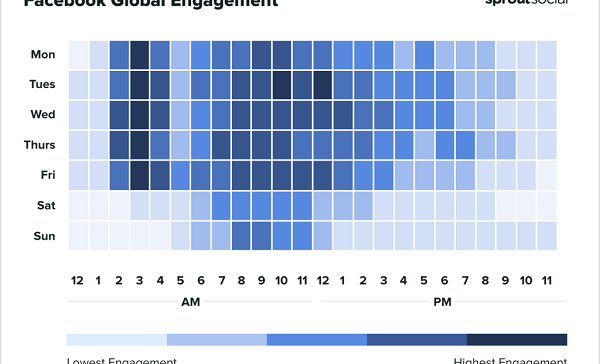SOCIAL
New Insights Highlight the Best Times to Post on Facebook and Twitter in 2022

Okay, these advice guides are always somewhat controversial, and yes, there are many factors and elements that can play into this data which would impact the performance relative to your own brand.
But in general terms, they can help – and this week, Sprout Social has published its latest insights into the best times to post on Facebook and Twitter, based on performance insights from Sprout’s 30k+ customer base.
Again, this is not prescriptive – this is not to say that all brands, definitively, will see optimal performance if they post at these times (worth noting, too, that the times listed at all CST, though they would be relative to your local time zone). But if you were looking to change up your posting process to improve performance, or maybe map out a more effective strategy, these times, based on current engagement trends, could be a good place to start.
First off, on Facebook – according to Sprout’s data, the best time to post your latest update to Facebook is 3am, Monday to Friday.
“What? 3am? What’s with that?”
Well, there are various factors that would play into this.
First off, at 3am, there’s likely a lot fewer people posting, which means less competition in the feed. That could mean that you get some early engagement which then helps to improve the reach of your post, and by, say, 9am, when more people are online, that early response could then help to ensure that your content is then shown to even more people.
Sprout also notes that the times are listed in CST, and 3am CST is also:
- 9am British Standard Time
- 10am Central European Time
- 6pm Australian Eastern Standard Time
So because you’re looking at global engagement, you also need to factor in regional variability – i.e. it’s not just people in your time zone that you’re reaching.
Depending on Sprout’s user base, that could be a significant factor, so it’s worth also analyzing who you’re reaching, geographically, within your Facebook Insights.
But as you can see in the chart, 3am, Monday to Friday, sees better engagement, while Tuesdays at 10am and noon also drives good response.
Sprout further notes that the worst day to post on Facebook, in terms of engagement, is Saturday, with Sunday not looking much better.
Worth factoring into your experiments.
On Twitter, Sprout’s engagement data suggests that the best time to post is 9am on Monday, Tuesday, Wednesday, Friday and Saturday.

It seems that people are more inclined to log into Twitter at 9am in order to catch up with the news of the day – except on Thursdays, when everyone’s, I guess, looking forward to the weekend instead?
The data likely reflects the real-time nature of the tweet feed, and how people use the app to keep up with the latest developments, which could be worth factoring into your planning.
Sprout says that the best days to post to Twitter are Tuesdays and Wednesdays, with Sundays being the worst for tweet engagement.
Overall, the data provides some interesting pointers for your own experiments. But again, this is not prescriptive, and there are many factors, as noted, that are relative to your audience, and how your community engages with your content.
But it may get you thinking about your posting approach, which could highlight new opportunities.
Sprout has also published industry-specific breakdowns in its full overviews of Facebook and Twitter engagement insights.
SOCIAL
Snapchat Explores New Messaging Retention Feature: A Game-Changer or Risky Move?

In a recent announcement, Snapchat revealed a groundbreaking update that challenges its traditional design ethos. The platform is experimenting with an option that allows users to defy the 24-hour auto-delete rule, a feature synonymous with Snapchat’s ephemeral messaging model.
The proposed change aims to introduce a “Never delete” option in messaging retention settings, aligning Snapchat more closely with conventional messaging apps. While this move may blur Snapchat’s distinctive selling point, Snap appears convinced of its necessity.
According to Snap, the decision stems from user feedback and a commitment to innovation based on user needs. The company aims to provide greater flexibility and control over conversations, catering to the preferences of its community.
Currently undergoing trials in select markets, the new feature empowers users to adjust retention settings on a conversation-by-conversation basis. Flexibility remains paramount, with participants able to modify settings within chats and receive in-chat notifications to ensure transparency.
Snapchat underscores that the default auto-delete feature will persist, reinforcing its design philosophy centered on ephemerality. However, with the app gaining traction as a primary messaging platform, the option offers users a means to preserve longer chat histories.
The update marks a pivotal moment for Snapchat, renowned for its disappearing message premise, especially popular among younger demographics. Retaining this focus has been pivotal to Snapchat’s identity, but the shift suggests a broader strategy aimed at diversifying its user base.
This strategy may appeal particularly to older demographics, potentially extending Snapchat’s relevance as users age. By emulating features of conventional messaging platforms, Snapchat seeks to enhance its appeal and broaden its reach.
Yet, the introduction of message retention poses questions about Snapchat’s uniqueness. While addressing user demands, the risk of diluting Snapchat’s distinctiveness looms large.
As Snapchat ventures into uncharted territory, the outcome of this experiment remains uncertain. Will message retention propel Snapchat to new heights, or will it compromise the platform’s uniqueness?
Only time will tell.
SOCIAL
Catering to specific audience boosts your business, says accountant turned coach

While it is tempting to try to appeal to a broad audience, the founder of alcohol-free coaching service Just the Tonic, Sandra Parker, believes the best thing you can do for your business is focus on your niche. Here’s how she did just that.
When running a business, reaching out to as many clients as possible can be tempting. But it also risks making your marketing “too generic,” warns Sandra Parker, the founder of Just The Tonic Coaching.
“From the very start of my business, I knew exactly who I could help and who I couldn’t,” Parker told My Biggest Lessons.
Parker struggled with alcohol dependence as a young professional. Today, her business targets high-achieving individuals who face challenges similar to those she had early in her career.
“I understand their frustrations, I understand their fears, and I understand their coping mechanisms and the stories they’re telling themselves,” Parker said. “Because of that, I’m able to market very effectively, to speak in a language that they understand, and am able to reach them.”Â
“I believe that it’s really important that you know exactly who your customer or your client is, and you target them, and you resist the temptation to make your marketing too generic to try and reach everyone,” she explained.
“If you speak specifically to your target clients, you will reach them, and I believe that’s the way that you’re going to be more successful.
Watch the video for more of Sandra Parker’s biggest lessons.
SOCIAL
Instagram Tests Live-Stream Games to Enhance Engagement

Instagram’s testing out some new options to help spice up your live-streams in the app, with some live broadcasters now able to select a game that they can play with viewers in-stream.
As you can see in these example screens, posted by Ahmed Ghanem, some creators now have the option to play either “This or That”, a question and answer prompt that you can share with your viewers, or “Trivia”, to generate more engagement within your IG live-streams.
That could be a simple way to spark more conversation and interaction, which could then lead into further engagement opportunities from your live audience.
Meta’s been exploring more ways to make live-streaming a bigger consideration for IG creators, with a view to live-streams potentially catching on with more users.
That includes the gradual expansion of its “Stars” live-stream donation program, giving more creators in more regions a means to accept donations from live-stream viewers, while back in December, Instagram also added some new options to make it easier to go live using third-party tools via desktop PCs.
Live streaming has been a major shift in China, where shopping live-streams, in particular, have led to massive opportunities for streaming platforms. They haven’t caught on in the same way in Western regions, but as TikTok and YouTube look to push live-stream adoption, there is still a chance that they will become a much bigger element in future.
Which is why IG is also trying to stay in touch, and add more ways for its creators to engage via streams. Live-stream games is another element within this, which could make this a better community-building, and potentially sales-driving option.
We’ve asked Instagram for more information on this test, and we’ll update this post if/when we hear back.
-

 MARKETING7 days ago
MARKETING7 days agoRoundel Media Studio: What to Expect From Target’s New Self-Service Platform
-

 SEO6 days ago
SEO6 days agoGoogle Limits News Links In California Over Proposed ‘Link Tax’ Law
-

 SEARCHENGINES5 days ago
SEARCHENGINES5 days agoGoogle Core Update Volatility, Helpful Content Update Gone, Dangerous Google Search Results & Google Ads Confusion
-
SEARCHENGINES7 days ago
Daily Search Forum Recap: April 12, 2024
-

 SEO5 days ago
SEO5 days ago10 Paid Search & PPC Planning Best Practices
-

 MARKETING6 days ago
MARKETING6 days ago2 Ways to Take Back the Power in Your Business: Part 2
-

 SEARCHENGINES4 days ago
SEARCHENGINES4 days agoWeekend Google Core Ranking Volatility
-

 MARKETING4 days ago
MARKETING4 days ago5 Psychological Tactics to Write Better Emails














You must be logged in to post a comment Login